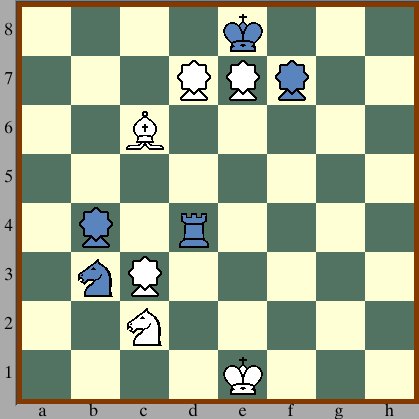King's Guard Chess
My design aims with this variant were threefold:- the game could be played using standard equipment;
- changes to FIDE rules should be few;
- it should be difficult for a computer to play well.
Setup
| The starting arrangement of Pawns and Pieces is exactly the same as
that found in FIDE
chess but with the Pawns adopting the King's (Guard's)
movement, thus
forming the King's Guard of this variant's
name. This initial set-up is shown in the top image on the right, where the Guard icon has been used for the Pawns.  This is to emphasise the Pawn's enhanced movement in this variant. In over-the-board play the Pawns can still be used though their movement and capturing abilities will be as described below. RulesUnless otherwise stated FIDE rules apply.All pieces, except the Pawn, move as in FIDE chess. Pawns move one square in any direction, like a King or Guard. There is no initial double-move for a Pawn and thus no en-passant capture. There is no castling. Pawns do promote on entering the far most rank. Only the Pawns may capture, and then only if assisted by a non-Pawn. A Piece provides an assist by attacking the square containing the enemy to be captured. Pawns may not assist. Kings, Queens, Rooks, Knights and Bishops assist; Pawns capture. This assisted capture is illustrated in the lower image on the right.
A side loses if:
White would also lose if Black's last Pawn had been promoted but had also captured White's King or in being promoted had rendered White unable to move (stalemate). | 
| ||||||||||

| |||||||||||
NotesAssisted Capture
There are variants that use methods of capture other than replacement
and there are variants where a piece's ability to capture is
restricted or non-existant; but I have not found one where capturing
consistently requires the
interaction of two different classes of piece. Perhaps I just
need to keep looking. The closest I can
find is the method used in Archimedes Chess where a piece is
captured if it is attacked by two or more enemy pieces. | |||||||||||
| Pawn |
1.0 |
| Knight |
2.0 |
| Bishop |
2.5 |
| Rook |
4.0 |
| Queen |
6.5 |
This seems to over-value the assisting pieces and under-value the Pawn. My initial guess would be that all pieces are of roughly equal value.
I hope, but cannot prove, that the unusual (I don't dare say unique) rule of capture with the need for cooperation between pieces will render current chess-playing algorithms at least partially ineffective.
 This 'user submitted' page is a collaboration between the posting user and the Chess Variant Pages. Registered contributors to the Chess Variant Pages have the ability to post their own works, subject to review and editing by the Chess Variant Pages Editorial Staff.
This 'user submitted' page is a collaboration between the posting user and the Chess Variant Pages. Registered contributors to the Chess Variant Pages have the ability to post their own works, subject to review and editing by the Chess Variant Pages Editorial Staff.
By Graeme C Neatham.
Web page created: 2008-06-12. Web page last updated: 2008-06-12
